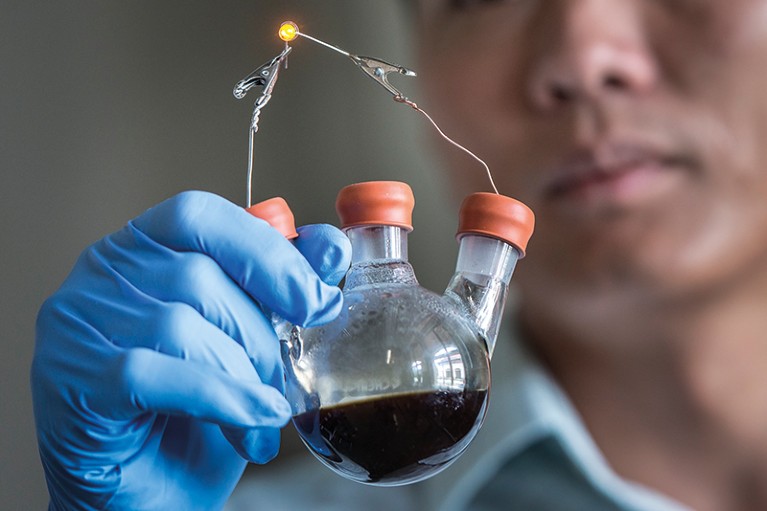
Industry funding supports more applied research, such as this lithium-polysulfide flow battery, which could serve as a model for low-cost, long-lasting energy storage.Credit: Matt Beardsley/SLAC
There is widespread agreement that collaborations between industry and academia are good for the businesses involved, and generally have a positive effect on the economy. Their influence on academic productivity, however, is a more ambiguous question. Some scientists worry that businesses, determined to keep intellectual property and profits for themselves, will delay the publication of studies or suppress negative results. Corporate pressure could also divert scientific efforts from fundamental studies, toward applied research. Several studies into the effect of corporate funding on scientific productivity have reinforced these fears.
But one analysis by business management researchers in the United Kingdom and United States suggests that corporate collaboration increases the productivity of academics after a discovery. “Researchers working with industry produce more follow-on publications,” says Keyvan Vakili at the London Business School, an author of the study, which is currently under review at a scientific journal.
Hindering science?
Industry–academia collaborations have been a small, yet enduring presence in the knowledge production system. According to the US National Science Foundation (NSF), industry has accounted for between 3 and 9% of academic research funding every year, going back to 1972. In 2014, the latest year available, it was US$3.6 billion, or 5.7% of total funding, on par with investment from non-profits, and state and local government.
The situation is similar in the UK and Germany, says Hanna Hottenrott, an economist at Technical University of Munich, Germany. She looked at corporate funding in the late 1990s and the effect it had on publishing and patenting by professors of engineering in the early 2000s. In the period she studied, corporate funding did not exceed 15% and 10% of the total investment in academic research in Germany and in the UK, respectively. More recent OECD estimates suggest that, in 2014, businesses contributed to about 14% of R&D expenditure in Germany, and 4% in the UK.
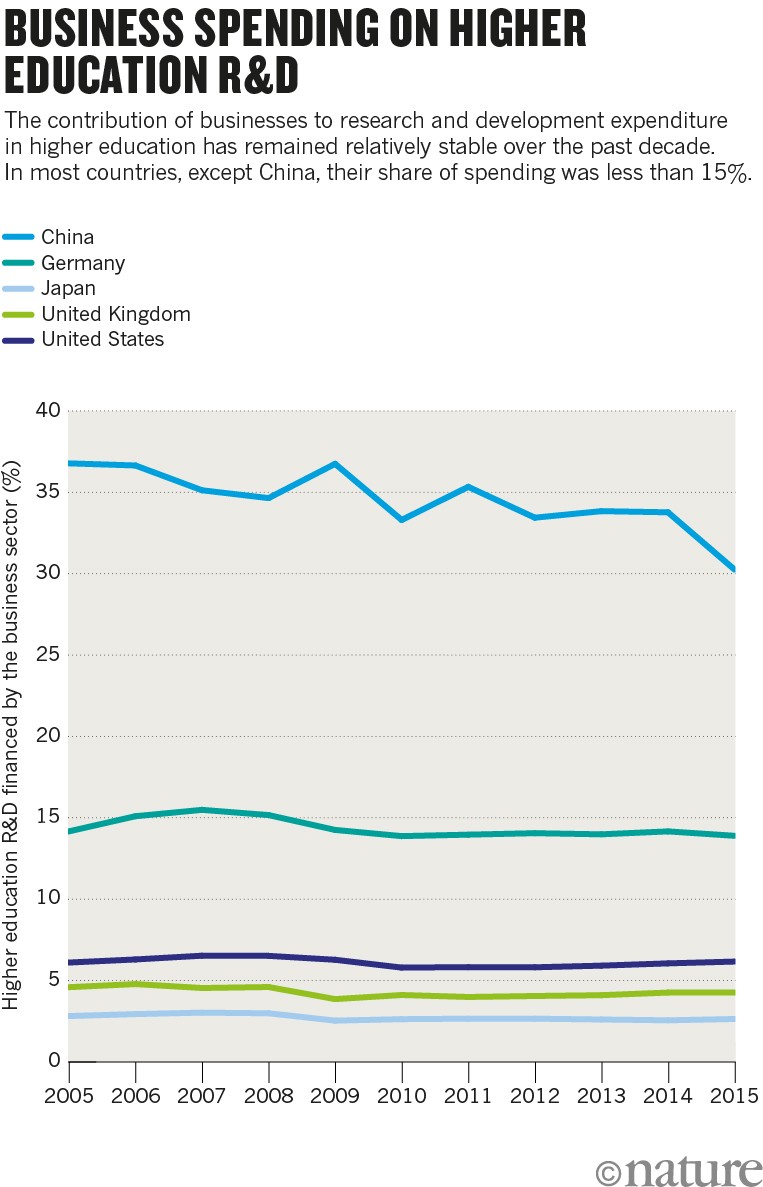
Source: OECD Main Science and Technology Indicators
Hottenrott’s analysis found that even a relatively small corporate contribution had a negative effect on scientific productivity. Academics working with industry saw a decrease in their publication rates and in the number of times they were cited by other researchers. At the same time, their patent numbers increased, which, she says, implies a shift to applied research. But the move from papers to patents should appease concerns over corporate confidentiality inhibiting publication productivity, says Hottenrott, as patents also disclose findings.
Vakili and his colleagues, Florenta Teodoridis, at the University of Southern California, and Michaël Bikard, also at the London Business School, were not entirely convinced by the negative results. The productivity differences observed by Hottenrott and other studies, says Bikard, could simply be due to how worthy of publishing a research project is. “Every piece of science is different, so it’s very difficult to know what causes what,” Bikard says.
Long division
To eliminate any confounding factors, the researchers looked at groups that were working on the same problems, with and without industry collaboration. They identified scientific discoveries that had been made more or less simultaneously by two or more different research groups between 1996 and 2008.
Most of the discoveries were in the life sciences, which Bikard says could be due to the fact that high-impact journals, Nature, Science, and Cell, publish more in those areas.
Part of Nature Index: Science Inc.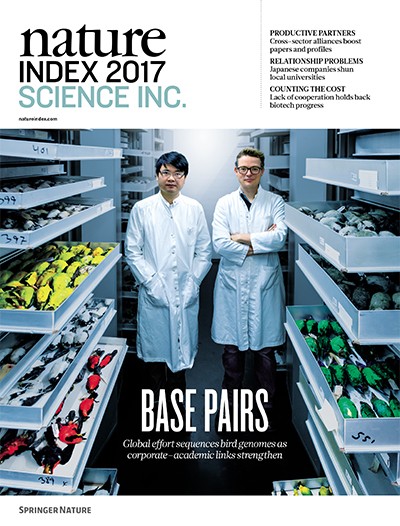
The team identified 33 of these ‘twin discoveries’, where at least one group had industry collaborators and one did not, and looked at their subsequent publication record. The team estimated that academics who worked with industry produced on average 7.7 more follow-up papers based on the discovery, publishing about a third more than those who didn’t collaborate. Somewhat surprisingly, the team found that academics in collaborations with industry filed fewer patents than academics on their own.
The increase in publishing and the decrease in patenting by academics who collaborate with industry could be a result of an efficient division of labour, Vakili suggests. Many scientists who don’t have industry collaborations are still interested in commercializing discoveries.
It could be, Vakili says, that those scientists devote some of their time to turning a discovery into a product and have less time to write papers. Meanwhile, in an academic–industry collaboration, the industry side could be focussed on the commercialization work, leaving the academics free to publish more.
While the twin study looked at collaborations where industry was actively involved in research, some collaborations are just financial, where firms provide grants to sponsor academics' work. In a separate analysis of papers in that dataset, Bikard says, the team found neither a positive nor negative effect on publishing from sponsorship. “We’re not saying that bringing money is not important,” he says, but industry sponsorship did not provide an edge, maybe because academics in the sample get enough funding from other sources.
More positives
Other research has seen positive effects of industry funding. A 2017 paper in World Neurosurgery found that industry funding was associated with increased scholarly impact among academic neurosurgeons, as measured by their h-index, which counts a researcher’s publications and the rate at which they are cited. A 2007 study in PLOS ONE found that, for papers published in leading medical journals, industry funding was associated with a 26% increase in citation rates, suggesting that the research was considered important.
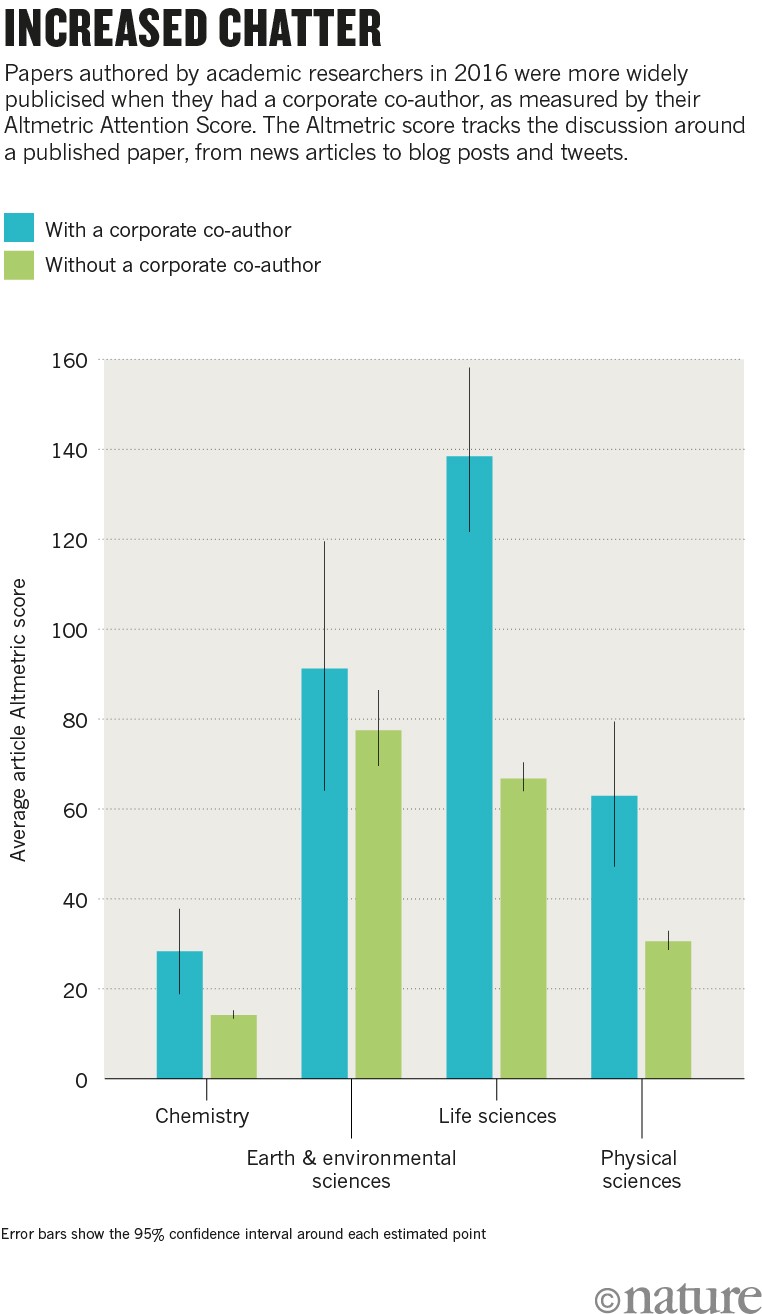
Source: Nature Index & Altmetric
Academic publications were also more likely to grab public attention if they included a corporate co-author, according to an analysis of the high-quality papers tracked by the index. The social media chat around a publication authored by an academic researcher, measured by its altmetric attention score, more than doubled when a corporate researcher was involved. Industry can provide other benefits to academics besides financial support, says Anthony Boccanfuso, head of the University-Industry Demonstration Partnership, a non-profit organization originally sponsored by the US National Academy of Sciences to help academia and business collaborate.
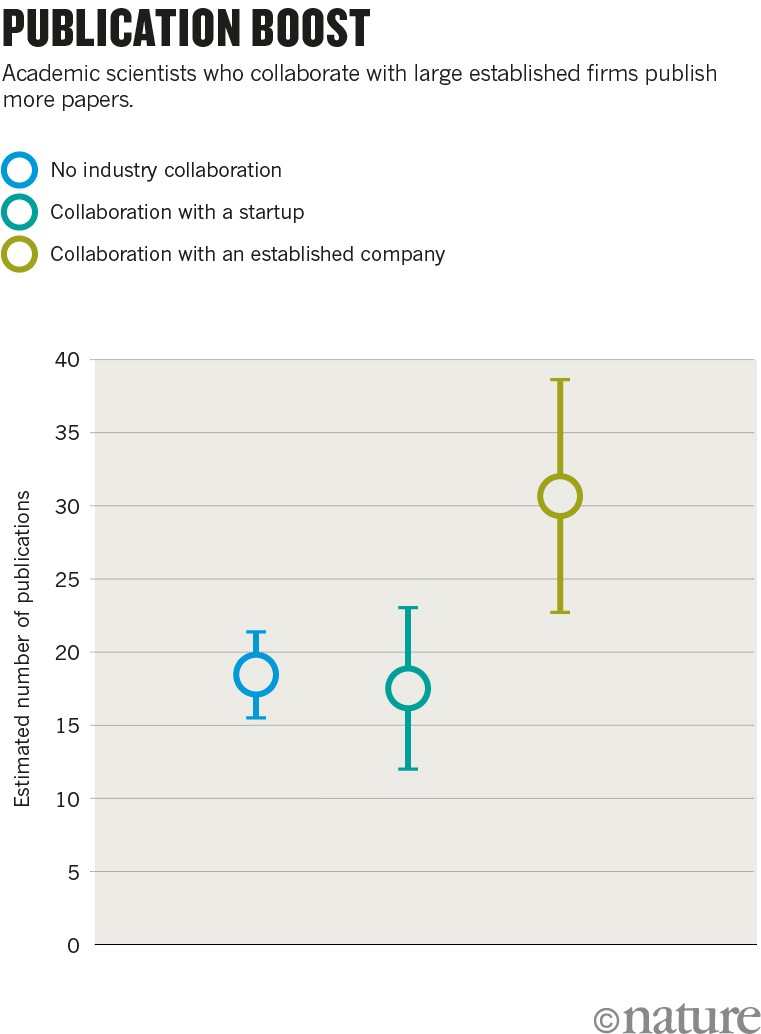
Bikard, M., Vakili, K. & Teodoridis, F. (2017)
For one, corporations often have technologies or materials — a piece of equipment or a cell line, say — that they don’t sell, but that can help scientists. Businesses that work with university researchers often also hire graduate students. A large majority of science graduates do not get faculty jobs. Showing them research opportunities outside academia is important for attracting students to science in the first place. “If universities want their people to be employed, to be prepared to be employees, working with industry during their graduate studies is a real benefit,” Boccanfuso says.
And, he points out, industry is not alone in pulling research out of the lab. Most funding agencies are also eager to see the science they support translate into a public benefit, which often means commercializing discoveries.
“Increasingly, federal agencies are looking for either explicit or implicit business validation for university research ideas, especially for large projects,” says Boccanfuso.
The National Institutes of Health (NIH) wants new drugs in the marketplace, the Department of Energy wants better batteries or catalysts, and the Department of Agriculture wants better crops.
Some programmes, like the NIH’s Clinical and Translational Science Awards and the National Network for Manufacturing Innovation require some level of collaboration. The NSF is even partnering with companies such as Intel and VMWare to co-sponsor research grants. As these interests converge, corporate influence on science will only become more difficult to decipher.


 Outsourcing discovery
Outsourcing discovery
 A firm shift
A firm shift
 Papers to patents
Papers to patents
 Help wanted: industry seeks science allies
Help wanted: industry seeks science allies
 Lost opportunities
Lost opportunities
 In good company
In good company
 First among equals
First among equals
 Corporates make reluctant partners
Corporates make reluctant partners
 A guide to the Nature Index
A guide to the Nature Index








